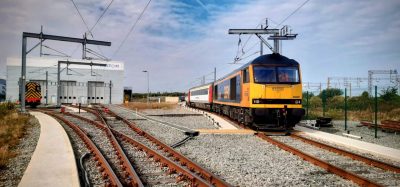Harmotrack: Investigating acceleration measurements to monitor track quality
Posted: 8 July 2022 | Danilo Sorrentino | No comments yet
Danilo Sorrentino, Head of Vehicle-Track Interaction Section at SNCF Réseau, explains the UIC Harmotrack Project; a worldwide project which brings together companies across five continents to tackle the most challenging topics relating to railway dynamics, track geometry and track maintenance.


The monitoring and maintenance of track quality is one of the most challenging tasks for infrastructure managers. A high quality and reliable railway track are prerequisites for a safe and secure railway operation. To achieve this, a periodic assessment of railway tracks is necessary to ensure the safety of railway passengers and the satisfaction of railway clients. Over the years, several approaches to track quality assessment have been developed to evaluate track performance.
For decades, the assessment of track quality has been dominated by the analysis of track geometry defects. The track measurements are collected by track measuring vehicles and compared to established thresholds. These thresholds have been established through the combination of safety, reliable railway operation, and required maintenance effort.
Recently, several railway networks have considered the use of acceleration measurements to monitor the track quality. The use of acceleration measurements presents great advantages compared to the current methods of track quality assessment. Firstly, it does not necessarily require specific measuring equipment, as it can be easily measured on every railway vehicle. This gives infrastructure managers the opportunity to obtain more measurement data compared to current methods, which increases frequency of inspections and allows for predictive and smarter maintenance. Secondly, it is relatively cheap compared to other track quality assessment methods. Accelerometers’ prices are lower compared to a measuring wheelset or a track inertial measuring unit.
Despite its advantages, its implementation in maintenance processes brings great challenges. The difficulty lies in various factors that affect dynamic measurements such as track layout, track geometry, measuring conditions, vehicle, data treatments, and other elements. These factors must be controlled to produce consistent thresholds for the maintainer. To overcome these challenges and explore the superiority of acceleration measurements, the UIC Harmotrack Project was initiated under the leadership of myself as Head of Vehicle-Track Interaction Section at SNCF Réseau, in collaboration with David Villalmanzo Resusta, Chairman of the Train-Track Interaction Sector at the UIC, and David Mirayo, former Infrastructure and Train-Track Interaction Senior Advisor at the UIC.
At first, the Harmotrack Project started as an international benchmarking project to understand how infrastructure managers from across the globe use acceleration measurement for track monitoring. The initial goal of the project was to produce a benchmark document on acceleration measurements. However, increasing interest from infrastructure managers and railway companies to understand the relation between track geometry and train dynamics, saw the scope of the project expanded further.
Currently, the UIC Harmotrack Project has more than 75 member railway companies and research institutions with more than 200 international railway experts. It is present in more than 40 countries from six continents all around the globe. The Harmotrack Project aims to achieve the following objectives:
- Establish an international benchmark to carry out state-of-the-art measurement techniques for dynamic responses (accelerations and forces)
- Define the domain of use for acceleration measurements
- Define representative/reliable indicators of track quality (increased vigilance, interventions, or slowdowns) based on accelerations for improved network maintenance and simulation purposes
- Contribute to enhancing safety and reducing costs on all networks by prioritising the correction of track geometry defects, focusing on those with the most dangerous impact on vehicle dynamics
- Propose these thresholds on accelerations in future international standards or technical recommendations.
These objectives will allow the Harmotrack Project, together with its members, to be recognised as one of the forerunners to define a new international standard on accelerations. Currently, there are no current rigorous standards on the use of acceleration measurement to monitor track quality.
To assess such a vast subject, different subworking groups (SWGs) were created within the project. The different SWGs and their brief summary are as follows:
- SWG 1 – determination of threshold for acceleration
- SWG 1 A – the SWG have come together to study the correlation of forces and accelerations, with the intent to recover force measurement signals in order to provide an estimation of Y/Q and Σi Yi, led by Fatih Ünlü, SBB CFF FFS
- SWG 1 B – study of correlation between acceleration and track geometry
- SWG 1 B Alpha – to assess the best, or nonetheless the optimal setup of a filter to apply to a specific acceleration signal, in order to represent the effects of the track-train interaction in the most realistic way, led by Fulvio Cianci, RFI and Hakki Küçükkeskin, TCDD
- SWG 1 B Beta – study of correlation between acceleration and track geometry: » SWG 1 B Beta 1 – the objective of the SWG is to define acceleration threshold for the most dangerous track geometry conditions through simulations using multibody simulations based on speed and the type of vehicle, led by Brian Marquis, US DOT, Volpe, Raphael Marotta, VLI Logística) and Ali Tajaddini, US DOT, FRA
- SWG 1 B Beta 2 – study of the correlation between acceleration and track geometry using statistical analysis, led by Danilo Sorrentino, SNCF Réseau, Florian Latestere, SNCF Réseau, Emily Greve and David Stolnis, Amtrak
- SWG 1 B Beta 3 – to investigate the machine learning methodologies in order to detect the track geometry irregularities using accelerometers measurements, led by Alfonso Panunzio, RATP, Cassandre Diaine and Samuel Pelisson, SNCF Réseau
- SWG 1 B Gamma – to study the occurrences and risk analysis, transferring thresholds from a reference vehicle to a different vehicle while taking into account possible various speeds, led by Nicolas Lestoille, SNCF Réseau and Maciej Pałyga, PKP PLK S.A.
- SWG 2 – to define the optimal use of axle box accelerometers to detect short length defects on specific locations on the track such as joints, welds and switches/crossings, led by Stanislaw Banaszak, SBB CFF FFS and Olivier Vo Van, SNCF
- SWG 3 – to explore the possibility of using low-cost portable devices (smartphones) for acceleration measurement as track monitoring systems, led by Franck Dadié, SNCF Réseau.
In order to ensure the smooth flow of activities of the sub-working group, regular meetings are organised by the SWG leaders. In addition, plenary meetings are also organised by the Harmotrack management team to guarantee the harmonisation of activities within the project.
The last Harmotrack Project plenary meeting was held in December 2021 at the UIC Headquarters and SNCF facilities in the Paris region (France). The event was organised in collaboration with UIC, led by Mercedes Gutierrez Ferrandiz, Head of Asset Management, Infrastructure and Interfaces with Rolling Stock for UIC. It was a great success and gathered more than 200 international experts from more than 100 companies and research institutions across the globe.
On the first day of the plenary meeting, roundtable discussions and technical presentations from the different SWGs in the Harmotrack Project were organised and focused on the following topics:
1. Railway maintenance and predictive maintenance with Marco Gallini, Head of the Mobile Diagnostics and Maintenance Vehicles Department at RFI, Atsushi Furukawa, Executive Director at RTRI and Albert Wahba, Programme Leader at National Research Council Canada
2. The importance of railway digitalisation and data analysis of autonomous systems with Emmanuel Cox, Digital Transformation Officer at SNCF Réseau, Sébastien Denis, Programme Manager at Shift2Rail and Gerald Schinagl, Innovation Manager at ÖBB
3. Harmonisation of global practices: the key to foster railway sector development with Patrizia Gatti Gregori, Top Executive Director of Sustainable Development at KEOLIS, Andrea Giuricin, CEO of TRA Consulting and Eneida Elezi, Foreign Affairs responsible Officer, at Albanian Railways S.A. and Ministry of Infrastructure and Energy.
On the second day, 30 international experts attended three parallel technical activities held at SNCF facilities: the Track Test Centre (Centre d’Essais Voie – CEV), the Metallurgic Expert Laboratory (Laboratoire d’Expertises Métallurgiques – LEM) in Saint-Ouen (France), and the Railway Test Agency (Agence d’Essai Ferroviaire – AEF) in Vitry-sur-Seine (France). The technical visits were facilitated thanks to the assistance of Elodie Arlaud, SNCF Réseau, Jolan Lottin, SNCF Réseau, Thi Mac Lan Nguyen-Tajan, SNCF Voyageurs and Philippe Pouligny, SNCF Réseau.
The Harmotrack Project is a truly exciting project that could change the way we see track maintenance as it is today. There is still significant work to be done, but its members are committed to achieving the aims of the project.
More information
To know more about the Harmotrack Project, contact Danilo Sorrentino ([email protected]) or the Harmotrack Management Team (harmotrack@ reseau.sncf.fr). The next Harmotrack Project plenary meeting will be co-hosted by Network Rail and the University of Birmingham, and is scheduled for 13 & 14 June 2022 in Birmingham (United Kingdom). Further details of the plenary meeting will soon be published by the UIC.


Global Railway Review Autumn/ Winter Issue 2025
Welcome to 2025’s Autumn/ Winter issue of Global Railway Review!
The dynamism of our sector has never been more apparent, driven by technological leaps, evolving societal demands, and an urgent global imperative for sustainable solutions.
>>> Read the issue in full now! <<<







